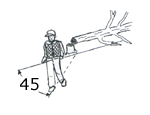How to Remove a Tree
Before you start | Felling the tree | Removing the stump
Removing a tree is a large decision that should not be taken lightly. Dead or dying trees should be removed for health, safety and aesthetic purposes. However, in certain instances live trees also should be removed when they interfere with other trees, buildings, driveways and utility wires. But think twice, as it takes years and often decades to replace a tree once removed.
This TreeHelp guide covers trees of reasonable diameter (caliper) and height; diameter up to about 10 inches and height of not much more than 20 feet. It is also based on the trees being on reasonably level ground. For owners of bluff or shoreline property where the root system is different, tactics will change. Click here for more information .
Keep in mind that removing a tree can affect more than just your property. If a tree is on or near a property line, removals can lead to disputes and/or legal action. The best strategy is communication with all parties involved.
Large trees should be removed by a professional as guide ropes and mechanical equipment may be required for removing large limbs before felling. If a tree is being removed due to interference with utility lines, you should contact your local utility company.
Tree removal is not as overwhelming as it seems, but certain steps must be followed in order to achieve a safe and successful removal.
Step-by-Step
1. Check the surrounding area for obstacles that may be in the way; another tree, a fence, overhead wires, the pride and joy perennial garden, cars, etc.
|
|
|
Establish an escape route
|
2.Stand back and observe the way the tree is naturally leaning. The best fall would be its natural angle of growth. Check the tree itself for safety hazards such as dead or hanging branches. Check the trunk of the tree for open wounds as wounds could indicate that the centre of the tree is hollow or rotten. Felling a rotten or hollow tree at the stump height is best left to professionals as you may not be able to control the direction of the fall or the tree may fall prematurely, endangering you and others around you.
3. Establish two escape routes that can be used while tree if falling, one on each side of the tree leading away from the expected fall line.


